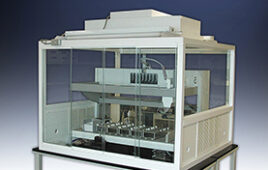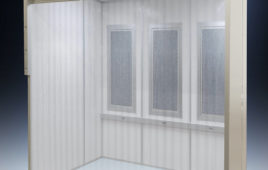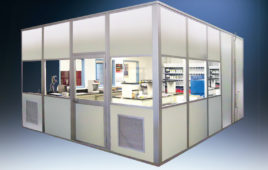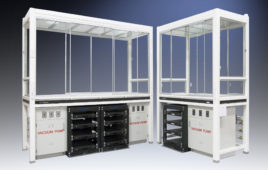The Institute for Electronics and Nanotechnology (IEN) is one of the founding NSF interdisciplinary academic research centers dedicated to nanotechnology discovery and development. The IEN evolved from its original focus as a NSF Microelectronics Research Center (founded in 1981) at Georgia Tech’s Atlanta campus. In 2009, the name was changed to the Nanotechnology Research Center (NRC) to reflect its physical expansion into the Marcus Nanotechnology Building (MNB) and research expansion into the growing realm of nanotechnologies applications.
 More recently, as part of Georgia Tech’s (GT) push to consolidate capital-intensive research, the NRC was combined with similarly-themed research centers (including NSF-funded graphene research, the Packaging Research Center, and the Georgia Electronic Design Center) to form an interdisciplinary research hub on campus, the IEN. Over the years, Georgia Tech has used these centers and their associated facilities to become the one of the world leaders in nanoscale science and engineering, with research programs spanning biomedicine, materials, electronics, photonics/optics, and energy. The IEN is comprised of multiple academic electronics and nanotechnology research centers, each offering a unique intellectual focus ranging from basic discovery and innovation to systems integration. The IEN has approximately 115 GT faculty users and more than 500 GT student users as well as nearly 200 users from other academic institutions and industries. Through the NSF’s National Nanotechnology Infrastructure Network (NNIN), IEN facilities are accessible to all U.S. academic users at the same price afforded by campus-based faculty.
More recently, as part of Georgia Tech’s (GT) push to consolidate capital-intensive research, the NRC was combined with similarly-themed research centers (including NSF-funded graphene research, the Packaging Research Center, and the Georgia Electronic Design Center) to form an interdisciplinary research hub on campus, the IEN. Over the years, Georgia Tech has used these centers and their associated facilities to become the one of the world leaders in nanoscale science and engineering, with research programs spanning biomedicine, materials, electronics, photonics/optics, and energy. The IEN is comprised of multiple academic electronics and nanotechnology research centers, each offering a unique intellectual focus ranging from basic discovery and innovation to systems integration. The IEN has approximately 115 GT faculty users and more than 500 GT student users as well as nearly 200 users from other academic institutions and industries. Through the NSF’s National Nanotechnology Infrastructure Network (NNIN), IEN facilities are accessible to all U.S. academic users at the same price afforded by campus-based faculty.
IEN cleanroom, fabrication, and characterization capabilities
 The IEN runs one of the largest university cleanroom complexes in North America. The IEN’s core mission is to provide exceptionally high value, fee-based open user access to research cleanrooms and laboratories at its core facilities. The IEN cleanroom has two on-campus locations: the Pettit Microelectronics Building (PMB), opened in 1988; and the Marcus Nanotechnology Building (MNB), opened in 2009. Together, these two facilities provide fully integrated electronics/materials cleanrooms; separate biological cleanroom space; a state-of-the-art characterization and microscopy suite housed in a vibrationally and acoustically shielded space; and supporting labs, equipment, and technical expertise. The expanded space enables Georgia Tech faculty, students, and non-GT users from academia, state and federal labs, and industry to carry out pioneering nanoscale research. Both the Pettit and Marcus facilities include significant laboratory space that house faculty research labs immediately proximate to the cleanroom and microscopy facilities.
The IEN runs one of the largest university cleanroom complexes in North America. The IEN’s core mission is to provide exceptionally high value, fee-based open user access to research cleanrooms and laboratories at its core facilities. The IEN cleanroom has two on-campus locations: the Pettit Microelectronics Building (PMB), opened in 1988; and the Marcus Nanotechnology Building (MNB), opened in 2009. Together, these two facilities provide fully integrated electronics/materials cleanrooms; separate biological cleanroom space; a state-of-the-art characterization and microscopy suite housed in a vibrationally and acoustically shielded space; and supporting labs, equipment, and technical expertise. The expanded space enables Georgia Tech faculty, students, and non-GT users from academia, state and federal labs, and industry to carry out pioneering nanoscale research. Both the Pettit and Marcus facilities include significant laboratory space that house faculty research labs immediately proximate to the cleanroom and microscopy facilities.
Pettit houses an 8,500 sq. ft. cleanroom (Class 10-100), while the Marcus building includes 10,000 sq. ft. of inorganic fabrication cleanroom space (Class 100) as well as 5,000 sq. ft. of biological cleanroom space (Class 1000), including Biosafety Level 1 and 2 labs. The inorganic and organic cleanrooms are adjacent so that researchers can transfer their samples without exposing them to a non-cleanroom environment. This novel design enables a seamless fusion of traditional, top-down microfabrication approaches (e.g. optical and electronbeam lithography) and various types of bottom-up self assembly approaches (typical biologically-derived) to nanotechnology research at Georgia Tech. The Marcus building also houses a newly-completed 3,300 sq. ft. imaging and characterization suite that offers comprehensive microscopy and imaging services, as well as X-ray and ion-based characterization, for a wide variety of materials and devices.
The IEN cleanrooms and labs accommodate over two hundred individual pieces of equipment, which enable users to run an extensive variety of materials growth and fabrication processes in a single facility. These processes include traditional microfabrication processes such as photolithography and mask generation; thin film deposition; plasma etching and wet chemistry; and packaging. Electron beam lithography and nano-imprinting services offer the ability to quickly prototype nanoscale devices on different substrates. Traditional chemical vapor deposition (CVD) materials growth, including atomic layer deposition as well as non-traditional process such as soft lithography, are also available. IEN cleanroom users come from numerous different academic departments within Georgia Tech’s Colleges of Engineering and Science, as well as the
Georgia Tech Research Institute (GTRI).

 The mission of the IEN is to maintain these current resources while also growing our capabilities through the acquisition of new high-tech tools; train users on safe and proper operation of the equipment; and provide the highest caliber technical expertise to enable users to achieve their desired results. These facilities, along with a skilled and experienced staff, has enabled Georgia Tech to be the hub of nanotechnology research in the southeast and competitive with the best U.S. national university facilities.
The mission of the IEN is to maintain these current resources while also growing our capabilities through the acquisition of new high-tech tools; train users on safe and proper operation of the equipment; and provide the highest caliber technical expertise to enable users to achieve their desired results. These facilities, along with a skilled and experienced staff, has enabled Georgia Tech to be the hub of nanotechnology research in the southeast and competitive with the best U.S. national university facilities.
The cleanroom as a controlled environment
Fundamentally, having a fully controlled environment is crucial in nanotechnology research and development. Particle levels, temperature, humidity, pressure, light, ultrapure water, and process gases all play important roles in achieving the conditions needed to conduct successful
research.
One of the challenges of user-centered facilities is that most new users do not have experience working in a cleanroom and lack familiarity with the unique operational conditions that come with this environment. To assist with acclimation, the IEN provides mandatory orientation programs to educate new users about cleanroom operation, safety, regulations, training, and protocols. Before being granted unsupervised access to any specific piece of equipment, users are required to attend training and pass a hands-on check-off test by facility staff. The IEN also offers seminars, workshops, forums, and staff office hours to assist users with process or engineering.
Particle contamination is the biggest concern for maintaining a controlled cleanroom environment. Cleanroom suits must be worn at all times to avoid cleanroom users’ skin and hair generating particulate contamination. Every item that users bring into the cleanroom must be cleanroom compatible (especially with regard to particle contamination) and fully decontaminated before entering to maintain the required cleanroom conditions. Non-cleanroom designed paper, notebooks, and cardboard containers are not allowed inside, and any chemical bottles, plastic boxes, or other instruments need to be wiped completely prior to taking inside the cleanroom. Before a new piece of equipment can be installed in the facility, it must be decontaminated multiple times in a dedicated cleaning area. Any particle producing process must be conducted in a well-ventilated area. The cleanroom staff checks particle levels on a regular basis to monitor any changes in airborne contamination.
 In the Pettit cleanroom, process equipment is located in bays separated by chases which contain supporting items such as pumps, chilled water, gas cabinets, exhaust scrubbers, power supplies, and other support equipment. These supporting systems do not need to be in the highly controlled environment, so isolating them in the chases reduces the amount of expensive cleanroom space one has to construct. In addition, allowable particle levels are controlled separately from bay to bay. For example, the photolithography bay has a Class 10 environment while the metallization bay is Class 1,000. In contrast, the Marcus inorganic cleanroom is a flow-through, ballroom design where all equipment is located within the same 10,000 sq. ft. open area. The challenge of maintaining low particle counts throughout the facility is addressed by maintaining a higher flow rate on the clean air return to those cleanroom sections that require it. With this approach, we have been successful in keeping these low particle count sections of the cleanroom at Class 100 level.
In the Pettit cleanroom, process equipment is located in bays separated by chases which contain supporting items such as pumps, chilled water, gas cabinets, exhaust scrubbers, power supplies, and other support equipment. These supporting systems do not need to be in the highly controlled environment, so isolating them in the chases reduces the amount of expensive cleanroom space one has to construct. In addition, allowable particle levels are controlled separately from bay to bay. For example, the photolithography bay has a Class 10 environment while the metallization bay is Class 1,000. In contrast, the Marcus inorganic cleanroom is a flow-through, ballroom design where all equipment is located within the same 10,000 sq. ft. open area. The challenge of maintaining low particle counts throughout the facility is addressed by maintaining a higher flow rate on the clean air return to those cleanroom sections that require it. With this approach, we have been successful in keeping these low particle count sections of the cleanroom at Class 100 level.
Many of the fabrication processes are sensitive not only to particle levels, but also to other environmental parameters such as temperature, humidity, and vibration. The IEN cleanroom has a network of sensors monitoring the variation in these parameters, and the data can be directly read in real time via a web interface, along with historical data covering longer periods of times to identify trends. Many of the warnings and alarms from the sensor network are sent immediately to cleanroom staff on their mobile devices so they can rapidly identify problems and fix them.
Ultimately, maintaining the appropriate controlled environment relies upon collaboration between staff and users. Users report to staff any problems or concerns about the cleanroom environment, and they also help staff to identify potential problems, warn other users of improper behavior, and do some routine housekeeping work. Everyone who uses and benefits from the cleanroom has the responsibility of keeping the facility safe.
 Summary
Summary
The product of a well-controlled environment is high quality research. Supported by the IEN cleanroom, Georgia Tech faculty, students, and research staff, as well as our research affiliates from other universities and companies, have published journal articles, presented at conferences, and filed patents based on discoveries realized within the IEN facilities. In addition, this research has led to a number of successful startup companies founded by GT faculty and students.
Dr. Paul J. Joseph is Principal Research Scientist and Dr. Hang Chen is Research Scientist II at the Georgia Tech Institute for Electronics and Nanotechnology. Drs. Joseph and Chen wish to thank their support team at Georgia Tech for their assistance with this article. www.ien.gatech.edu
This article appeared in the January/February 2015 issue of Controlled Environments.




